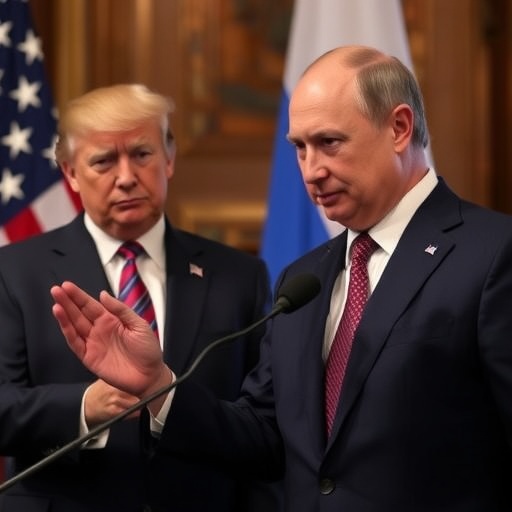US, Russia, and Ukraine Edge Closer to Diplomatic Solution in Three-Year War, Putin’s Envoy Reveals
In a stunning development that could reshape the geopolitical landscape of Eastern Europe, Kirill Dmitriev, a key envoy for Russian President Vladimir Putin, has announced that Russia, the US, and Ukraine are “quite close to a diplomatic solution” to end the protracted three-year war. This revelation comes amid heightened tensions and follows the postponement of a highly anticipated summit between US President-elect Donald Trump and Putin, signaling potential cracks in the ongoing conflict that has claimed hundreds of thousands of lives and devastated economies worldwide.
The statement, delivered during an interview with a major international news outlet, underscores a rare moment of optimism in a conflict that began with Russia’s full-scale invasion of Ukraine in February 2022. Dmitriev, who serves as the head of Russia’s sovereign wealth fund and has been instrumental in backchannel diplomacy, emphasized that negotiations have progressed further than at any point since the war’s outset. “We are talking about real progress,” he said, hinting at frameworks that could address territorial disputes, security guarantees, and reconstruction efforts without delving into specifics that might jeopardize the talks.
Putin’s Envoy Spotlights Progress in Trilateral Negotiations
Kirill Dmitriev’s comments mark a pivotal shift in the rhetoric surrounding the war between Russia, the US, and Ukraine. As Putin’s trusted advisor on economic and international affairs, Dmitriev has been quietly facilitating discussions that involve high-level representatives from all three nations. Sources close to the negotiations, speaking on condition of anonymity, reveal that recent virtual meetings have focused on de-escalation measures, including potential ceasefires in key battlegrounds like Donetsk and Kharkiv.
The envoy’s optimism is grounded in concrete steps: according to diplomatic leaks reported by Reuters, a joint working group comprising US State Department officials, Ukrainian Foreign Ministry delegates, and Russian negotiators has drafted preliminary agreements on humanitarian corridors and prisoner exchanges. These could serve as building blocks for a broader diplomatic solution. Dmitriev elaborated, “The involvement of the US has been crucial; their mediation has brought us closer to common ground than ever before.”
However, challenges remain. Ukraine’s President Volodymyr Zelenskyy has long insisted on full Russian withdrawal from occupied territories, a demand echoed by US allies in NATO. Russia’s position, as articulated by Foreign Minister Sergey Lavrov in recent UN speeches, prioritizes recognition of Crimea and the Donbas regions as sovereign Russian territory. Bridging this gap will require concessions, but Dmitriev suggested that economic incentives—such as lifting Western sanctions on Russia—could sweeten the deal for Moscow.
Statistics from the United Nations paint a grim picture of the war’s toll, underscoring the urgency of a diplomatic solution. Over 10,000 civilians have been killed, with millions displaced, and Ukraine’s economy has shrunk by 30% since 2022, per World Bank data. On the Russian side, military expenditures have ballooned to over $100 billion annually, straining an already sanctioned economy.
Postponed Trump-Putin Summit Stirs Speculation on Timing
The postponement of a planned summit between Donald Trump and Vladimir Putin has added layers of intrigue to the path toward a diplomatic solution in the US-Russia-Ukraine dynamic. Originally slated for mid-December in a neutral location like Istanbul, the meeting was intended to kickstart direct talks under Trump’s incoming administration. Trump, who has repeatedly criticized the war’s prolongation and pledged to end it “in 24 hours,” viewed the summit as a cornerstone of his foreign policy reset.
White House sources attribute the delay to logistical issues and scheduling conflicts, but analysts speculate it reflects deeper strategic maneuvering. “This isn’t a cancellation; it’s a recalibration,” said Fiona Hill, a former US National Security Council official and Russia expert, in an interview with CNN. The postponement allows time for behind-the-scenes negotiations to mature, potentially avoiding premature public scrutiny.
Trump’s team has been vocal about prioritizing diplomacy over military aid. In a recent Fox News appearance, incoming Secretary of State Mike Pompeo reiterated, “President Trump is committed to bringing peace to Ukraine without endless escalation.” This stance contrasts with the Biden administration’s approach, which has funneled over $60 billion in aid to Kyiv since 2022. The shift could pressure Ukraine to engage more flexibly in talks, even as European allies like Germany and France express concerns over a potential US pivot toward Russia.
From Moscow’s perspective, the delay might be a tactic to test Trump’s resolve. Putin has historically used such pauses to consolidate domestic support, with state media portraying the war as a defensive stand against NATO expansion. Recent polls by the Levada Center show 70% of Russians support negotiations, up from 50% last year, indicating public fatigue that could bolster Putin’s hand in pursuing a diplomatic solution.
Three-Year War’s Devastating Legacy Fuels Push for Peace
The war between Russia and Ukraine, now entering its fourth year, has evolved from a regional skirmish into a global crisis, drawing in the US and its allies while exposing fractures in international alliances. What began as a bid by Russia to annex eastern Ukrainian territories has escalated into a brutal stalemate, with frontline cities like Avdiivka reduced to rubble and Black Sea shipping routes disrupted, causing global food prices to spike by 20% in 2022 according to the FAO.
Key milestones in the conflict include Russia’s initial blitz toward Kyiv in 2022, which stalled due to fierce Ukrainian resistance bolstered by Western arms. The US has played a pivotal role, providing Javelin missiles and HIMARS systems that shifted battlefield dynamics. Yet, as casualties mount—estimated at 500,000 combined by UK intelligence—the appetite for a diplomatic solution has grown. Zelenskyy’s “peace formula,” unveiled at the 2022 G20 summit, demands restoration of 1991 borders, war crimes trials, and security guarantees, but Russia has dismissed it as unrealistic.
Backchannel efforts have persisted despite public impasses. The Istanbul talks of March 2022 nearly yielded a deal, with Ukraine agreeing to neutrality in exchange for territorial concessions, per reports from Turkish mediators. Subsequent attempts, including Swiss-hosted rounds in 2023, faltered over enforcement mechanisms. Dmitriev’s latest statement revives hopes that US involvement under Trump could revive these stalled initiatives.
Economically, the war has reshaped global energy markets. Russia’s invasion led to a surge in natural gas prices, hitting Europe hardest, with Germany facing a 40% energy cost increase. Ukraine, meanwhile, has lost 25% of its agricultural output, exacerbating food insecurity in Africa and the Middle East. These ripple effects highlight why a diplomatic solution is not just desirable but essential for stabilizing the world economy.
- Military Impact: Over 1,000 tanks destroyed on each side, per Oryx open-source intelligence.
- Humanitarian Crisis: 6 million Ukrainian refugees in Europe, UNHCR data.
- Economic Sanctions: $300 billion in frozen Russian assets, used partially for Ukraine’s reconstruction.
Global Powers React to Whispers of a Ukraine Peace Deal
News of a potential diplomatic solution involving the US, Russia, and Ukraine has elicited a spectrum of reactions from world leaders, with cautious optimism tempered by skepticism. In Washington, bipartisan lawmakers urged vigilance; Senate Foreign Relations Committee Chair Ben Cardin warned, “Any deal must prioritize Ukraine’s sovereignty—no shortcuts for aggressors.”
European Union foreign policy chief Josep Borrell echoed these sentiments, stating in Brussels, “The EU stands ready to support a just peace, but not at the expense of international law.” NATO Secretary General Jens Stoltenberg, speaking at a Brussels press conference, affirmed the alliance’s commitment to Ukraine’s defense while welcoming diplomatic overtures. “Peace through strength remains our mantra,” he added.
In Kyiv, reactions were mixed. Ukrainian Ambassador to the US Oksana Markarova told Politico, “We’re open to talks, but only if they lead to lasting security.” Public sentiment in Ukraine, per a recent Kyiv International Institute of Sociology poll, shows 60% favoring negotiations if they ensure territorial integrity, a shift from earlier hardline stances.
China, a key Russian ally, has positioned itself as a mediator. Beijing’s foreign ministry praised the progress, with spokesperson Wang Wenbin noting, “A political settlement aligns with the interests of all parties.” This comes as China increases grain imports from Russia, underscoring its stake in war’s end. Meanwhile, India and Brazil, via BRICS channels, have called for de-escalation, with Brazilian President Lula da Silva proposing a global peace summit.
The involvement of non-Western powers adds complexity. Iran’s drone supplies to Russia and North Korea’s artillery contributions have prolonged the war, but a US-brokered deal could isolate these actors, potentially leading to broader arms control talks.
Path Forward: Challenges and Opportunities in Securing Lasting Peace
As Russia, the US, and Ukraine inch toward a diplomatic solution, the road ahead is fraught with hurdles but brims with transformative potential. Experts foresee a multi-phase process: first, an immediate ceasefire monitored by UN observers; second, territorial negotiations possibly involving referendums in disputed areas; and third, long-term security arrangements, including demilitarized zones and NATO non-expansion pledges for Ukraine.
Reconstruction will be monumental, with the World Bank estimating $486 billion needed for Ukraine alone. Frozen Russian assets could fund this, but legal battles loom. Trump’s administration might leverage this as a carrot, tying aid to verifiable Russian withdrawals.
Geopolitically, a successful deal could mend US-Russia ties strained since 2014’s Crimea annexation, reducing nuclear risks—both nations maintain over 5,000 warheads each. For Ukraine, peace means reclaiming its future, fostering EU integration and economic revival. Yet, spoilers like far-right Ukrainian factions or Russian hardliners could derail progress.
Looking ahead, the postponed Trump-Putin summit, now eyed for early 2025, could seal the framework. As Dmitriev concluded, “The window for diplomacy is open—let’s not let it close.” If realized, this diplomatic solution could end not just the war, but an era of confrontation, ushering in a more stable Eurasia.
Developments will be watched closely, with international monitors urging transparency to build trust. The stakes are global: peace in Ukraine could avert wider conflicts, stabilize energy markets, and refocus efforts on shared challenges like climate change.









